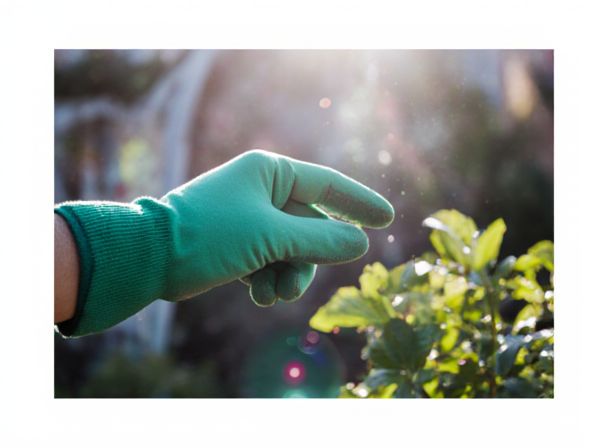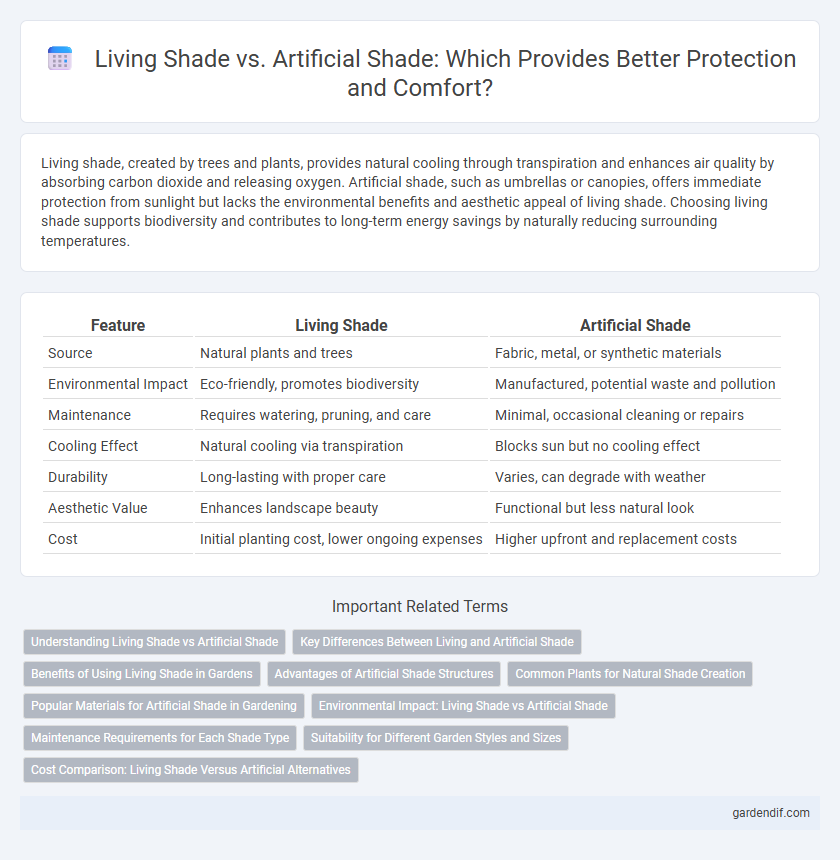
Living Shade vs Artificial Shade Illustration
Living shade, created by trees and plants, provides natural cooling through transpiration and enhances air quality by absorbing carbon dioxide and releasing oxygen. Artificial shade, such as umbrellas or canopies, offers immediate protection from sunlight but lacks the environmental benefits and aesthetic appeal of living shade. Choosing living shade supports biodiversity and contributes to long-term energy savings by naturally reducing surrounding temperatures.
Table of Comparison
| Feature | Living Shade | Artificial Shade |
|---|---|---|
| Source | Natural plants and trees | Fabric, metal, or synthetic materials |
| Environmental Impact | Eco-friendly, promotes biodiversity | Manufactured, potential waste and pollution |
| Maintenance | Requires watering, pruning, and care | Minimal, occasional cleaning or repairs |
| Cooling Effect | Natural cooling via transpiration | Blocks sun but no cooling effect |
| Durability | Long-lasting with proper care | Varies, can degrade with weather |
| Aesthetic Value | Enhances landscape beauty | Functional but less natural look |
| Cost | Initial planting cost, lower ongoing expenses | Higher upfront and replacement costs |
Understanding Living Shade vs Artificial Shade
Living shade, created by trees and plants, offers natural cooling benefits through transpiration and air filtration, enhancing outdoor comfort and environmental health. Artificial shade structures, such as canopies and umbrellas, provide immediate and customizable protection from sunlight but lack the ecological advantages of living shade. Understanding the differences helps in selecting the appropriate shade solution for sustainability, aesthetics, and functionality in outdoor spaces.
Key Differences Between Living and Artificial Shade
Living shade, created by trees and plants, provides natural cooling through transpiration and improves air quality by absorbing carbon dioxide and releasing oxygen. Artificial shade, such as fabric canopies or metal structures, offers immediate, customizable protection from sunlight but lacks environmental benefits and requires maintenance to prevent weathering. The key differences lie in ecological impact, air purification, temperature regulation, and durability.
Benefits of Using Living Shade in Gardens
Living shade in gardens enhances biodiversity by supporting local flora and fauna, creating a natural habitat that artificial shade cannot replicate. It improves air quality through photosynthesis and contributes to cooling effects by reducing heat absorption in the environment. Additionally, living shade structures increase soil health by preventing erosion and maintaining moisture levels, promoting sustainable garden ecosystems.
Advantages of Artificial Shade Structures
Artificial shade structures provide consistent protection from UV rays, reducing heat exposure and minimizing sun damage effectively. They offer customizable designs and materials, allowing for durability and easy maintenance in various weather conditions. These structures also enable greater flexibility in placement and size compared to natural shade, ensuring optimal coverage in diverse environments.
Common Plants for Natural Shade Creation
Common plants for natural shade creation include large canopy trees such as oak, maple, and elm, which provide dense, cooling cover through their extensive foliage. Fast-growing species like the silver birch and poplar are popular for quickly establishing shaded areas while enhancing air quality and supporting local ecosystems. Unlike artificial shade structures, these living shades offer ecological benefits, including habitat for wildlife and carbon sequestration.
Popular Materials for Artificial Shade in Gardening
Popular materials for artificial shade in gardening include UV-resistant shade cloth, polyethylene fabric, and metal mesh, all designed to provide effective sun protection while ensuring durability. Polyethylene fabrics offer excellent breathability and water resistance, making them ideal for plant health and longevity. Metal mesh shades provide sturdy support and partial light filtration, which helps regulate temperature and light intensity for optimal plant growth.
Environmental Impact: Living Shade vs Artificial Shade
Living shade, provided by trees and plants, contributes to carbon sequestration, improves air quality, and supports biodiversity, making it an environmentally sustainable option. Artificial shade structures often rely on materials like metal, plastic, or fabric, which have a higher carbon footprint due to manufacturing, transportation, and disposal processes. Choosing living shade reduces greenhouse gas emissions and fosters ecological balance compared to the resource-intensive lifecycle of artificial shade solutions.
Maintenance Requirements for Each Shade Type
Living shade, created by trees and plants, requires ongoing maintenance such as watering, pruning, fertilizing, and pest control to ensure healthy growth and effective canopy coverage. Artificial shade, like pergolas or shade sails, demands minimal upkeep beyond periodic cleaning and inspections for structural integrity or fabric wear. The cost and labor associated with living shade maintenance are generally higher but provide environmental benefits, while artificial shade offers convenience and consistent protection with lower long-term maintenance.
Suitability for Different Garden Styles and Sizes
Living shade created by trees and shrubs offers natural cooling and enhances biodiversity, making it ideal for large gardens and naturalistic or cottage-style landscapes. Artificial shade structures, such as pergolas and retractable awnings, provide flexible and customizable coverage suitable for small urban gardens and modern, minimalist designs. Choosing between living and artificial shade depends on garden size, style preferences, and maintenance willingness.
Cost Comparison: Living Shade Versus Artificial Alternatives
Living shade, created by trees and plants, offers long-term cost savings through natural cooling, reduced energy bills, and minimal maintenance expenses compared to artificial shade structures. Artificial alternatives such as pergolas, awnings, and shade sails often require upfront investment, periodic repairs, and replacements, increasing their overall lifetime cost. Evaluating factors like installation price, durability, and environmental impact reveals living shade as a more cost-effective and sustainable option.
Living Shade vs Artificial Shade Infographic

 gardendif.com
gardendif.com